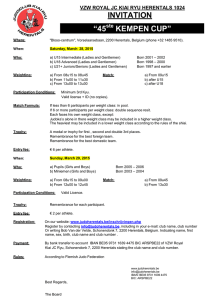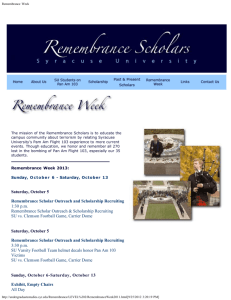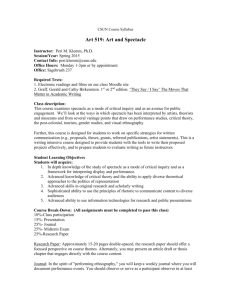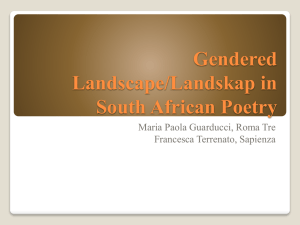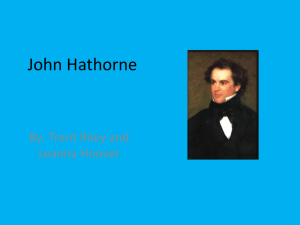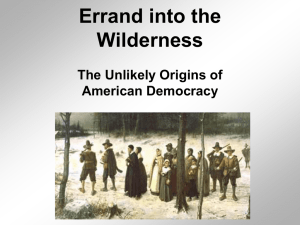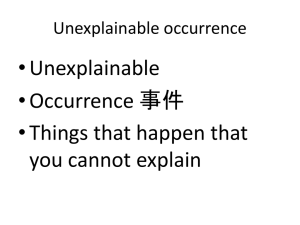Remembrance – Black Power & TV Spectaculars
advertisement
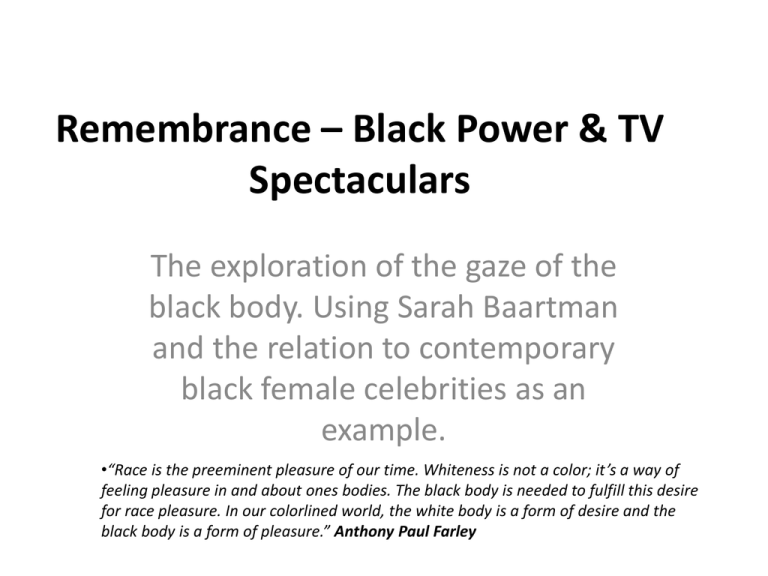
Remembrance – Black Power & TV Spectaculars The exploration of the gaze of the black body. Using Sarah Baartman and the relation to contemporary black female celebrities as an example. •“Race is the preeminent pleasure of our time. Whiteness is not a color; it’s a way of feeling pleasure in and about ones bodies. The black body is needed to fulfill this desire for race pleasure. In our colorlined world, the white body is a form of desire and the black body is a form of pleasure.” Anthony Paul Farley Remembrance re·mem·brance 1.a. The act or process of remembering.b. The state of being remembered: holds him in fond rememberance.2. Something serving to celebrate or honor the memory of a person or event; a memorial.3. The length of time over which one's memory extends.4. Something remembered; a reminiscence.5. A souvenir.6. A greeting or token expressive of affection. Remembrance can be defined in a number of ways. It is often referred to as the process of remembering, or the state of being remembered. Remembrance can be applied at certain events or by certain personal artefacts that revoke the memory of an happy or devastating event, for example 9/11, or a living being that has passed, that is practiced globally. Although you might not personally remember an event, the act of remembrance can still be performed. For example, wearing a poppy on Remembrance Sunday. The people in this room were not alive during the battle of the Somme, but how many of you wear a poppy on Remembrance Sunday? Remembrance can be a form of respect, not just an activity in the brain. Remembrance of Sarah Bartmaan Remembrance helps people celebrate, respect and remember Creation of the Sarah Baartman centre of remembrance in Hankey 2013/2014 financed by the National department of arts and culture “ A multi-purpose space of national significance” Arts and culture minister Pallo Jordan However remembrance is not always respectful Swedish minister of culture carving up cake and eating it on Worlds arts day Black Power Definition: • A political slogan and a name for various associated ideologies aimed at achieving self-determination for people of African/Black descent. • The movement flourished in the late 1960's as a result of the dissatisfaction of some black activists with the progress of the civil rights movement. • The black power movement embraced a variety of groups, among them SNCC (Student Nonviolent Coordinating Committee) , the Congress of Racial Equality, the Black Panthers, and the Black Muslims. Theories: • Such positions were for the most part in direct conflict with those of leaders of the mainstream Civil Rights Movements, and thus the two movements have often been viewed as inherently antagonistic. However, certain groups and individuals participated in both civil rights and black power activism. • While Stokely Carmichael and SNCC were in favor of black nationalism, organizations such as the Black Panther Party for Self-Defense were not. Though they considered themselves to be at war with a power structure that was indeed mostly white, they were not at war with all whites, merely the individuals in the existing power structure, who happened to mostly be white. Ideologies: • Though the aims of the Black Power movement were racially specific, much of the movement’s impact has been its influence on the development and strategies of later political and social movements. The Black Power movement created what other multiracial and minority groups interpreted to be a viable template for the overall restructuring of society. • By opening up discussion on issues of democracy and equality, the Black Power movement paved the way for a diverse plurality of social justice movements, including black feminism, environmental movements, affirmative action, and gay and lesbian rights. Central to these movements were the issues of identity politics and structural inequality, features emerging from the Black Power movement. The Black Power movement emphasized and explored a black identity, movement activist were forced to confront issues of gender, class and many more. TV spectaculars Definition •The idea of making a spectacle out of something. •In relation to Sarah Baartmans story she was the spectacle and used as a representation of the gaze of black female bodies. •Is there still an underlying racial stereotype going on ? •Explore Sarah Baartmaan •Explore black women •The gaze of the Black Body • Look at theorists discussing the black body as a fetish object Sarah Baartman • http://www.youtube.com/watch?v=iQ7mmMe4klQ • • • • • • • Sarah Baartman A woman from Africa who became a sexual spectacle in Europe A spectacle to be laughed at and humiliated. Forced to be looked at whilst nude. Became a prostitute died of sexual disease. Didnt stop there Vagina and brain was cut out and put in jars whilst her naked body was put in a museum. • When looking at the portrayal of black women in the media today ,we still see women like Nicki Minaj and Rihanna half naked, using their bodies to attract a wide audience and embracing it as power. Sarah Baartman didn’t participate with free will, however musicians like Nicki Minaj choose to represent themselves in an erotic light forgetting the struggle that Sarah went through . Is this perhaps because we have been engineered as a society to look at the black body as a tool of pleasure. Whether this is a good or bad thing depends on the audience. However the representations of a lot of the black celebrities aren’t far off from that of Sarah Baartman. Could you say that the black female form is still being exploited? And the gaze of the black body is still being used as a spectacle to attract worldwide attention? • Is that the way the music industry works? Indoctrinated slavery? Encouraging black people to look up to and behave in a certain way? Have artists been told to behave in a certain way to attract attention ? What does that say about our society ? Theories • Race as a sadomasochistic form of pleasure. The existentialist of sadism – The process by which one man tries to transform into a mere object of his will . • • Whiteness as a sadistic pleasure the black body as a fetish object Let the little childs mind be poinsoned by predjudice and its practically impossible to ever remove these impressions– J waities The white identity is created and maintained by decorating black bodies with disdain over and over again. Race is the form of pleasure in ones body which is achieved through humiliation of the other, and then ,as the last stop, through a denial of the entire process . We deny it through a discourse in which race appears as a thing created by nature and not as a practice developed by a culture . By denying their fetization of race whites create a culture in which they are both masters and innocents. • • • Baldwin asks – What is it to be done when your subalternation , your pain , is the source of a pleasure which supports a political order, which in turn secures your subalternation Gaze of the black bodies? These are some common examples of the typical representation of the black female within the media. In order to capture the audience and attract masses they use their body (wide hips, oversized bum, large breasts) to sell to their target audience. This is a great example of the black body as a fetish object when looking at the comparison between Sarah Baartman who was ‘forced’ to be a spectacle and humiliated.. Today stars like these are idolised by many young female teenagers as ‘strong’, ‘sexy’ independent women with perfect bodies. Do these women portray themselves like this because they want to and feel free and break so called boundaries or do they do it because there is an underlying expectation that black women should sexualise themselves to gain respect and attention in the media industry. Conclusion Although the black female appears to have gained more respect and power in the media , how far is this true when looking at theories suggesting that the black body is merely a fetish object, designed by the white body? We can conclude that there is still, perhaps, an underlying fetization of the black body . Sources:-+ • • ‘‘Black Power for Whom?’’ Christian Century (20 July 1966): 903–904. Branch, At Canaan’s Edge, 2006. Carmichael and Hamilton, Black Power, 1967. Carson, In Struggle, 1995. King, Address at SCLC staff retreat, MLKJP-GAMK. King, ‘‘Is It Not Enough to Condemn Black Power,’’ October 1966, MLKJP-GAMK. King, Statement on Black Power, 14 October 1966, TMAC-GA. King, Where Do We Go from Here, 1967. ‘‘Negro Leaders on ‘Meet the Press,’’’ 89th Cong., 2d sess., Congressional Record 112 (29 August 1966): S 21095–21102. Farley, Anthony Paul 76 Or. L. Rev. 457 (1997)
